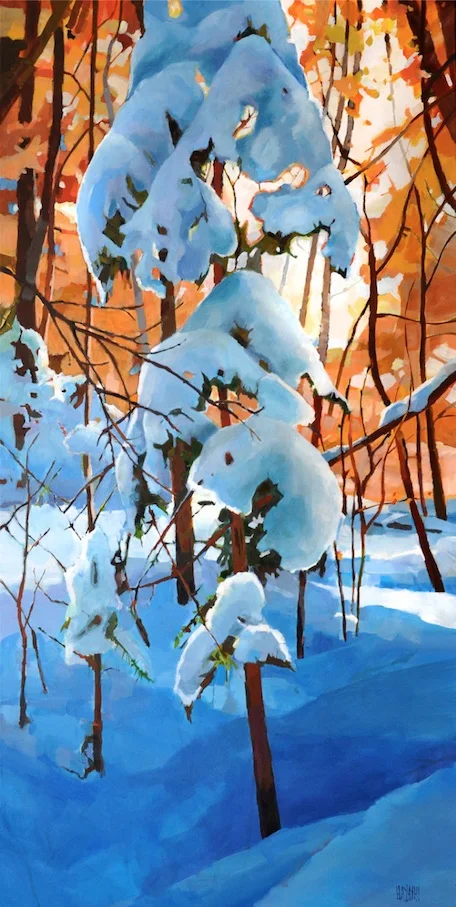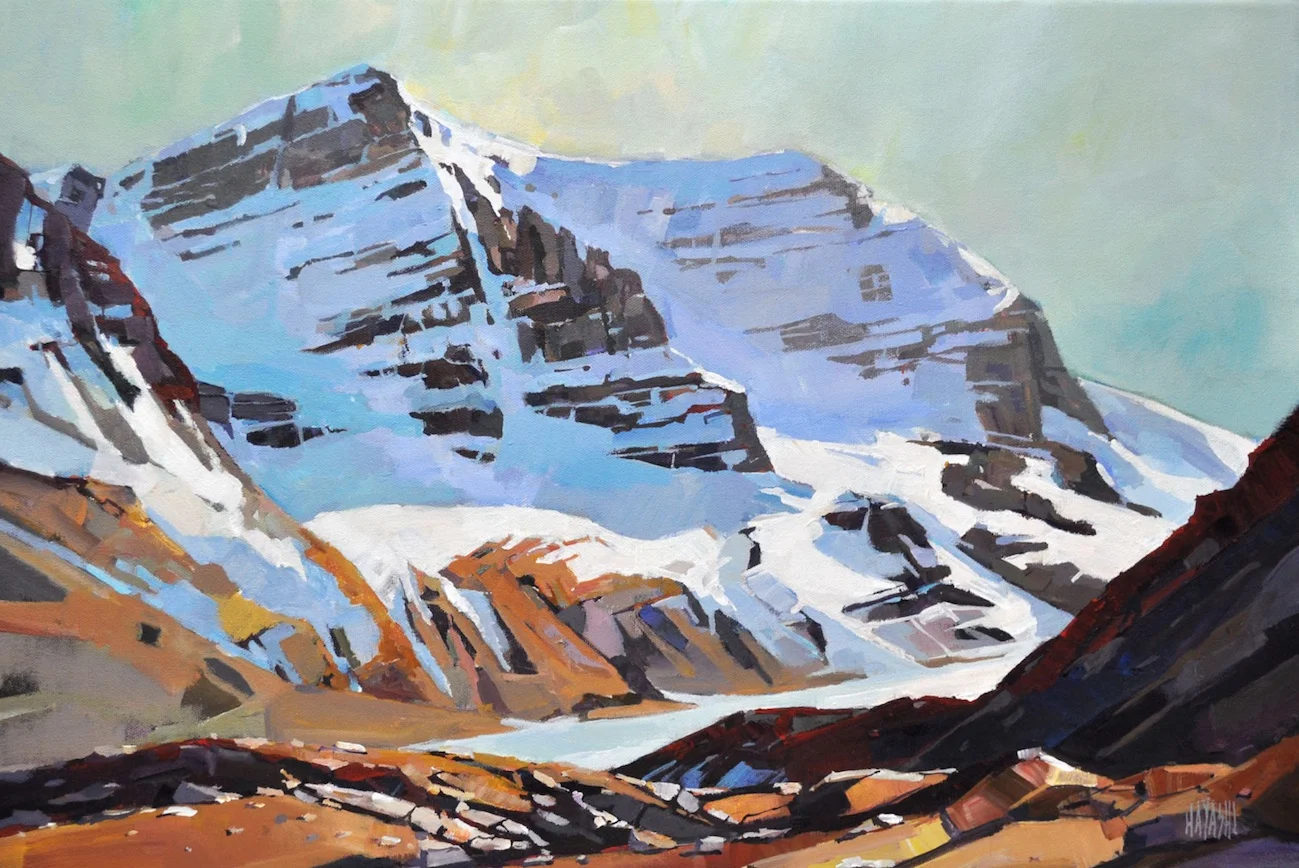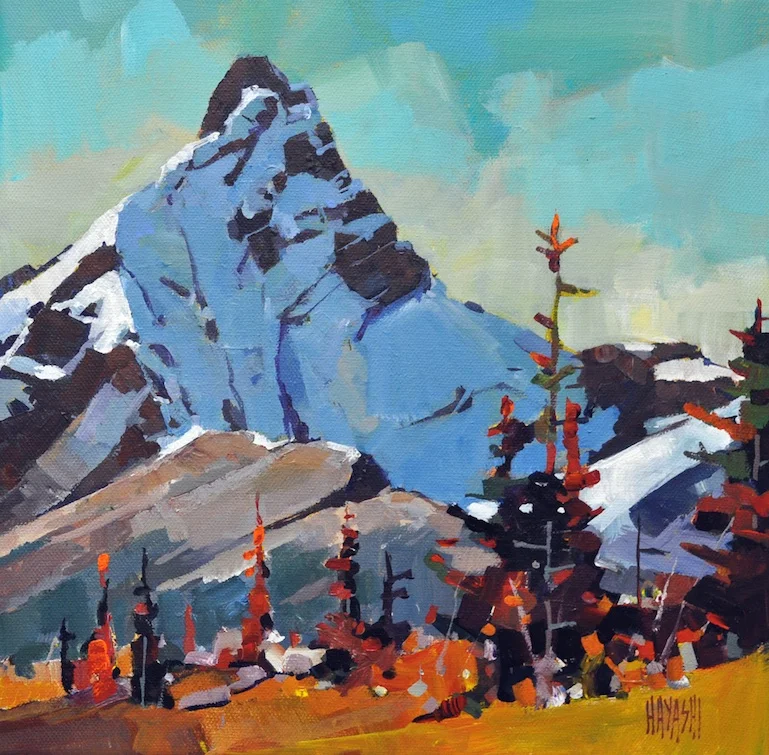Detail from Bugaboo Glaciers ©Randy Hayashi
Approximate reading time: 7 minutes.
This month I interview Canadian artist Randy Hayashi. His bold brush strokes and striking use of colour take the viewer through the most joyous celebration of mountains and wilderness.
Some of his work, such as "Snow Caked" which focusses on a snow-laden tree, provides a simple snapshot - a moment to savour - the kind of image that perfectly represents the exhilaration I have felt, when stopping for a brief moment to catch my breath when thumping through deep snow or perhaps taking a moment from snowboarding to simply soak in the wonder of nature.
Snow Caked ©Randy Hayashi
Interview:
AM: How did you come to mountains and wilderness as a subject matter?
RH: I enjoy all kinds of subject matter and I'll often paint a street scene, animal or people just to keep some variety. I do however gravitate towards landscape painting because of the unique shapes and lighting scenarios that the outdoors presents. The same scene can look completely different in another season or on a cloudy or clear day. The mountains are special because of their massive forms and the way that the light can change on faces of rock or snow, not to mention how low lying cloud or mist from falls can all come together in innumerable combinations to make a beautiful scene. I always feel refreshed after having spent time outdoors and believe there is a natural pull for me to paint these places because of the positive association of the outdoor experience.
AM: What is your relationship with mountains and the outdoors, beyond the canvas?
RH: I was born and raised in Edmonton, Alberta, Canada and our province has a very diverse landscape. We have prairies, rolling hills, and world class mountains! People come from all over the globe to see these special places. From where I live the mountains are about a 4 to 5 hour drive and Jasper and Banff are our wilderness playgrounds. When I was growing up my family would usually take a summer trip to the mountains where we would go fishing and do a bit of hiking. As I got older I did a lot of skiing and snowboarding and would go the mountains with my friends even just for the day. We would get up at 4am and drive 4 or 5 hours to get the first lift up the mountain. I don't have quite the same energy now, but the pull of the mountains is strong and I try and get to the mountains several times a year to hike, bike or board.
AM: I notice that you have only been a full time artist for a few years. How has this transition been?
RH: It was a slow process. I've been full time artist for just over four years, but was a graphic designer for 20 years before making the leap to full time painting. It was a gradual transition out of my design job and the company I worked for was very good to me and helped me move from 3/4 time to 1/2 to no time. This weening away from graphic design took a few years, but eventually I knew I had to let the 'regular' job go if I was really gonna make a go of painting.
AM: Do you work from home / studio and do you find it easy to discipline yourself to work to a timetable as if you were “going to the office”?
RH: I do work from home and have a small studio in my basement. Disciplining myself to work is definitely a challenge, but I usually make myself paint whether I want to or not. After all the years of having to log my time as a designer, I think this helped me be a little more regimented when it came to logging painting time. I often listen to podcasts or audio books while I paint, and I found The War of Art by Steven Pressfield a great book in addressing the profession of art.
AM: Where did you learn your craft?
RH: Since I was a kid I always enjoyed drawing and I drew little comic strips for my friends and lots of cars and trucks. I took art through my school years and when I graduated high school I went to a Grant MacEwan College for 2 years and learned more about visual fundamentals, painting, drawing and sculpture.
I thought about being an illustrator after this training, but was interested in product and and furniture design, so I transferred to the University of Alberta and took industrial design. I learned a lot more about visual communication and design during these years. When I graduated computers were beginning to boom and I latched onto a Mac and immersed myself into graphic design. I didn't touch a brush for at least 10 years, but somewhere around 2000 I began to dabble again and paint a painting here and there. By 2007 I was trying to paint more consistently in the morning before going to work and a little bit of time in the evening. I was only getting in about an hour a day, but as I kept reading and hearing from other artists it really comes down to putting in the time. I took a couple of workshops and scoured YouTube videos and books for tips and tricks which I found very helpful.
Andromeda Light ©Randy Hayashi
AM: Mountains, indeed the outdoors in general, poses obvious difficulties to the painter. Talk us through your process and your media - how much of your work is painted in situ?
RH: Most of my work is painted from photos that I take. I'm a studio painter and I think with all the years as a graphic designer on a computer I do a lot of my front end work for my paintings on the computer. A lot of photo manipulation and digital painting in Photoshop helps me get the compositions the way I want them. Using a Wacom tablet I do a lot of digital sketching and designing of the a painting.
The digital workspace gives me the flexibility to move things around quickly and try lots of different design scenarios. Depending on the painting I sometimes can put a couple of hours into this stage of the painting. Once I'm happy with my design I can begin painting. I typically start with the big shapes and go from dark to light, but it's a lot of back and forth. Dark over light and light over dark. The computer can help a lot, but it doesn't always guarantee or translate to a successful painting. I could wall paper my house a few times over with the amount of paintings that get chucked or painted over. I think it's just part of any artistic process.
I have done a little plein air painting and find it very challenging, especially with acrylic paint that dries very quickly. I've been experimenting with watercolour for plein air studies and am also trying a bit of sketching on the iPad.
AM: Your painting style is bold and quite fearless in the use of colour which feels to me like something that would develop over time as you become comfortable with your subject matter. Has your style changed and do you feel it continues to evolve?
RH: Thanks for saying so - it definitely doesn't always feel that way. I think the goal for me is to always get more bold and painterly and to be less tight. I know lots of painters say this and there is a fine balance and a never ending goal of achieving the yin and yang of looseness and draftsmanship.
I hope to bring more freshness to my work and more economy in my brush work... meaning I would like to get better at laying down only the strokes I need to and not overworking the piece. I think my style is changing and evolving and I'll occasionally look at some of my early work just to see the evolution and hope that it's getting better.
Right now I'm trying to implement more abstraction and thicker paint. I'm using scrapers and rags to try and get richer texture in certain passages and it's fun to experiment and try new things. What usually ends up happening is I take a little bit from these experiments and implement them in subsequent paintings.
Hilda Peak ©Randy Hayashi
AM: For me one of the great wonders of mountains and landscapes in the 'real world' is the fact that, to the human eye at least, they need no composition. How do you deal with capturing the wonder of nature within the boundaries of painting?
RH: You're right this is probably the most difficult part for any visual artist be they a movie maker, photographer or painter. This is also the beauty of art because we all bring a different interpretation to the experience of the place and for some reason 'our take on it' can resonate with others and create a “connection”. That's the fun part and the mysterious part of art. I think there's a lot of mystery in art and I believe people that appreciate and consume art like this mystery.
It's like relaying a story - good story tellers can fuel the imagination and engage the listener, but if the story teller isn't getting a good reaction he/she might end the story with a "you had to be there". Which is true most of the time because nothing beats being there and being fully immersed in the experience and surroundings. So I hope that my paintings can capture a bit of the viewer's memory of a place or somehow have a positive resonance with their own story.
AM: It strikes me that literature and film is comparatively well looked after, but do you think representative bodies or any organisations that represent lovers of the outdoors, be they climbers, skier, thru-hikers etc. do enough to promote artists who are depicting mountains?
RH: Speaking about my personal experience, I have participated in the Artist in Residence programs through Mountain Galleries that carry my work. The galleries are situated in three mountain resort towns. The people that come to these hotels are there for skiing, hiking and everything the mountains have to offer. It is a great partnership between the hotels and the gallery, and a chance to feature several artists through the year. Usually the artist stays a week in the hotel and is required to paint in the hotel's public space where visitors and guests can interact and learn more about the work and the gallery. I also know there are a few other Artist in Residence programs through the Canadian Government and I hope to participate in a few of those in the coming years.
I know this is a small piece and traditional form representation and when I think of all the mountain enthusiasts and some of my friends a lot of what they consume in exposure to the mountains and art is online through videos and short films. So much of what we do in the mountains is sport related and video is easily accessible and a powerful way to communicate a fuller story. I only know a couple of artists that make short films about how they do their work, and I think this is a great way to reach a broader audience. One such artist is Cory Trépanier and he does a brilliant job of being a painter and a film maker. I don't know Cory personally, but he would be an interesting guy to talk to about promoting landscape painting.
AM: Do you have a favourite mountain range or indeed a favourite mountain?
RH: There is a famous drive in Alberta between Banff and Jasper known as the Icefields Parkway and it is spectacular! There are several iconic views along this highway and many great places to hike. One of my favourite areas on this route is the Columbia Icefields where several glaciers converge and flow into mountain rivers and lakes. I have painted several scenes from this area and am never disappointed with the views no matter the weather.
AM: What’s next for Randy Hayashi? Do you have any upcoming exhibitions?
RH: There are currently no scheduled exhibitions, but there are usually a couple of group shows that happen through the galleries which I seasonally take part in. Last year I did a bit of teaching once a week and enjoyed the challenge of looking at all kinds of different work by fellow artists and discussing how to improve our paintings. I'm doing that again this year and am finding it a good exercise for me to articulate why things work and don't work which helps me in my own painting.
AM: Do you have a favourite historical or contemporary landscape or mountain painter you would draw people's attention to and if you could see one living mountain artist interviewed here who would it be?
RH: Being Canadian I have to say the Group of Seven! As well as Cory Trépanier (mentioned above) a contemporary painter that I have always admired is Robert Genn. I was hoping to take one of his workshops several years ago, but sadly he died of pancreatic cancer in 2014 and I didn't get the chance. I particularly admired his graphic approach to painting and in watching some of his youtube videos I admired his confident and economical brush work. He also has an ongoing email newsletter that his daughter Sara Genn (also an artist) continues called the The Painters Keys it has been running for several years and has thousands of subscribers.
You can find out more about Randy's work on his web site, and supporting galleries as well as follow him on Social Media.
website www.hayashi.ca
facebook www.facebook.com/randyhayashiart
instagram @randy_hayashi
Galleries:
www.mountaingalleries.com
www.gainsboroughgalleries.com
Copyright of all images ©Randy Hayashi




